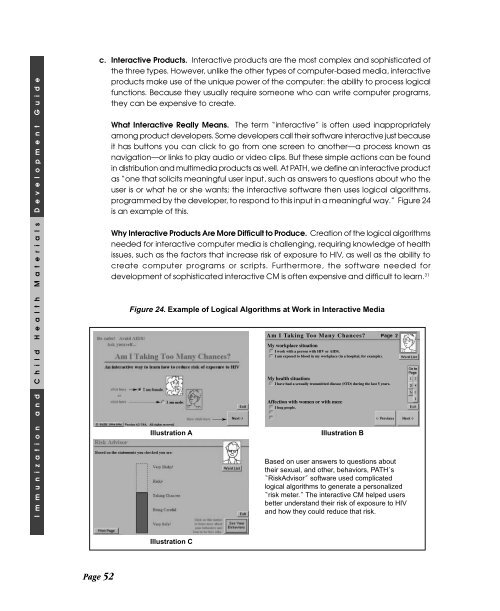Immunization and child health materials development guide pdf
Immunization and child health materials development guide pdf
Immunization and child health materials development guide pdf
Create successful ePaper yourself
Turn your PDF publications into a flip-book with our unique Google optimized e-Paper software.
c. Interactive Products. Interactive products are the most complex <strong>and</strong> sophisticated of<br />
the three types. However, unlike the other types of computer-based media, interactive<br />
products make use of the unique power of the computer: the ability to process logical<br />
functions. Because they usually require someone who can write computer programs,<br />
they can be expensive to create.<br />
What Interactive Really Means. The term “interactive” is often used inappropriately<br />
among product developers. Some developers call their software interactive just because<br />
it has buttons you can click to go from one screen to another—a process known as<br />
navigation—or links to play audio or video clips. But these simple actions can be found<br />
in distribution <strong>and</strong> multimedia products as well. At PATH, we define an interactive product<br />
as “one that solicits meaningful user input, such as answers to questions about who the<br />
user is or what he or she wants; the interactive software then uses logical algorithms,<br />
programmed by the developer, to respond to this input in a meaningful way.” Figure 24<br />
is an example of this.<br />
Why Interactive Products Are More Difficult to Produce. Creation of the logical algorithms<br />
needed for interactive computer media is challenging, requiring knowledge of <strong>health</strong><br />
issues, such as the factors that increase risk of exposure to HIV, as well as the ability to<br />
create computer programs or scripts. Furthermore, the software needed for<br />
<strong>development</strong> of sophisticated interactive CM is often expensive <strong>and</strong> difficult to learn. 31<br />
Figure 24. Example of Logical Algorithms at Work in Interactive Media<br />
Illustration A<br />
Illustration B<br />
Based on user answers to questions about<br />
their sexual, <strong>and</strong> other, behaviors, PATH’s<br />
“RiskAdvisor” software used complicated<br />
logical algorithms to generate a personalized<br />
“risk meter.” The interactive CM helped users<br />
better underst<strong>and</strong> their risk of exposure to HIV<br />
<strong>and</strong> how they could reduce that risk.<br />
Illustration C<br />
Page 52

















